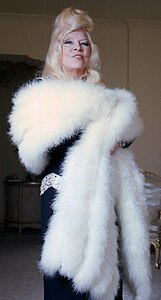Plumassier
As Plumassier refers to the profession of Federschmückers, and spring cleaners or spring milliners called (see milliner ). The French job title (the word comes from “la plume” - “the spring”) has been adopted into German and describes both men and women who carry out this manual activity. The tasks include cleaning, sorting and preserving the feathers. The so-called decorative feather is created through finishing processes by means of dyeing, shaping and cutting .
Tail, shoulder, breast and swing feathers from rooster , pheasant and goose are used as the starting material . Exotic feathers such as those from ostriches , parrots or from - now protected - birds of paradise are often used. In the present day the plumassier's activity is purely for decorative purposes. The processed decorative feathers are usually used to decorate clothing, e.g. as trimmings on collars or cuffs as well as on accessories such as boas , hats, helmets, headdresses, umbrellas, bags, fans, symbols of dignity or tapestries (the spring room from August is particularly well known here the strong in Moritzburg Castle (Saxony) ).
History / costume studies
From 1770, the late Rococo era , the robes for aristocrats at the court of Versailles in France were influenced by English court fashion, which was more opulent and even more richly decorated than before and was mainly worn as a gala dress ( grand parure ). In this context , the professions of the milleneur (today the English hatter is called "millener") and the decorative plumassier emerged .
The milleneur mainly made ribbons of fabric, flounces , bows , garlands and flowers from silk, with which the court clothes were decorated and adorned. The Plumassier processed predominantly down springs for bed sheets, the tips of quills for writing or bellows, which, slipped inside, were placed as a warming lining in winter in clogs (clogs).
The profession developed from the functional use of feathers to purely decorative purposes. Voluminous wigs, hats, umbrellas, fans, trimmings on collars and cuffs were decorated with feathers. Ostrich feathers worked into opulent wigs were in great demand . In the years 1880-1896 were despite the emerging sportiness to the matinee elaborate ceremonial hats worn or balls, which were richly decorated with silk flowers and feathers. At the beginning of the 20th century, feathers or bird skins , like those of birds of paradise or parrots, adorned the fashionable appearance of European women. These exotic feathers were then often combined with fur . In addition to elaborate hand embroidery, the use of feathers has remained in the fashion of Parisian haute couture to this day and is still operated by a few studios.
The plumassier's profession
Duties of the plumassier
Decorative feathers are used in hat fashion in Germany today and are adapted to the current colors. Ornamental feathers for traditional costume groups and music clubs in the form of hats are also produced. For costumes in the theater and revue, very large quantities of decorative feathers are often processed in a complex manner. Ornamental feathers can also be found less elaborately refined in costumes or accessories for carnival .
education
In Germany there is no possibility of training. Techniques and methods are passed on from mouth to mouth in small hat factories that use decorative feathers. The use of feathers is taught in material science and costume studies in the craft training for ladies' tailors and also in textile studies in the subject of fashion design at German universities of applied sciences.
Tools of the trade
Every Plumassier has his own techniques and therefore different tools. Commercially available steam irons, hand dampers and hairdressing scissors for cutting are often used for deformation.
Present and future of the profession
Decorative feathers are mostly used in Germany as hat feathers or as feather boa. A large area are spring sets for traditional costumes, also known as hooks and bumps .
Ballerina Olga Spessiva in swan costume ( Swan Lake , 1934)
Beverley Owen , Feather Dressed Dress (1964)
Mae West with Feather Stole (1964)
Berlin, " Carnival of Cultures ", feather costume (2007)
literature
- Ingrid Loschek : Reclam's fashion & costume dictionary . Philip Reclam jun., Stuttgart 1994, ISBN 3-15-010403-3 (first edition: 1987).
- Claudia Wisniewski: Small dictionary of costume and fashion . Philip Reclam jun., Stuttgart 1996, ISBN 3-15-004224-0 .
- Ralf Giermann: The feather room in Moritzburg Castle . Michel Sandstein Verlag, Dresden 2003, ISBN 3-930382-87-3 .
- Cornelia Hofmann, Birgit Tradler: The feather room of August the Strong . Verlag der Kunst, Dresden 2003, ISBN 3-364-00604-0 .
Web links
Individual evidence
- ^ " Essais historiques sur les modes et la toilette française " , Vol. II, Henri de Villiers, 1824






